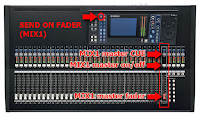This is similar to the setup for M7CL but some different features are available on your LS9.
1. TO PATCH MONITOR OUT (p.146 LS9 Owner's Manual)
The default patch does not include an XLR output for cue/monitor signals. To patch the monitor bus to an omni out;
2. Move the cursor to the port select box L located below the L level meter, and press the [ENTER] key.
3. Chose your output (OMNI 1 for example) and close the OUTPUT PORT SELECT popup window.
4. If you want to monitor in mono turn the MONO MONITOR button on to combine signals from ST IN channels and hear signals panned to the right.
5. If you want to monitor in stereo repeat steps 2-3 for the R side.
2. CUE LEVEL ON A FADER
Some stage monitor engineers like to have fader control of their Cue listening level.
LS9 has two ways to have the level control on a fader.
1. In the DISPLAY ACCESS section, press the [SETUP] key repeatedly to access the USER SETUP screen.
2. Move the cursor to the CUSTOM FADER LAYER popup button in the screen, and press the [ENTER] key.
3. Move the cursor to the channel module select field ("32" for example), use the dial or the [DEC]/[INC] keys to select the MONITOR to that field, and press the [ENTER] key.
4. Press the LAYER [CUSTOM FADER] key in the LAYER section to recall the custom fader layer you’ve created.
5. The fader 32 is now a level control for the Monitor/Cue output.
With the user defined key (p.196 LS9 Owner's Manual):
1. In the DISPLAY ACCESS section, press the [SETUP] key repeatedly to access the USER SETUP screen.
2. Move the cursor to the USER DEFINED KEYS popup button, and press the [ENTER] key.
3. Move the cursor to the button for the user defined key whose function you want to assign ("11" for example), and press the [ENTER] key.
4. Select MONITOR for the function and MASTER FADER for the parameter 1.
5. Press the user defined key 11 to turn the mode on and use the master fader to control the monitor level, and the ON key to switch the monitor output on/off. (LED=lit: Monitor level, LED=dark: Stereo/Mix Master)
3. MIX CUE AND MIX MASTER LEVEL CONTROL
When the SENDS ON FADER mode is activated, the master fader and the ON key control the related Mix master level and on/off. Also the CUE key engages the Mix master to the Cue bus.

Note
The Monitor Master fader mode with the user defined key has priority over assigning function to the master fader by the SENDS ON FADER. For that reason, the master fader assigned to Monitor Master fader mode stays as is even if SENDS ON FADER mode is activated.












